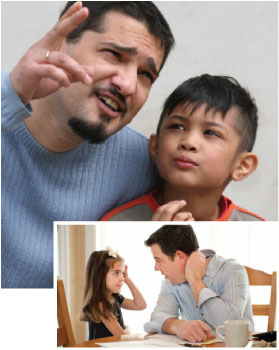Parenting involves engaging in situations from the profoundly serious to the embarrassingly funny. There are times when you may feel frustrated or angry. There are also fabulous experiences of revelation and learning about yourself, your children and many more things.
Children can be brutally honest and sometimes that can hit a nerve, possibly confirming that their comment is totally relevant. One thing that is great about bringing up children or being involved with children is that every day is different. As you learn and support their learning, real lessons of life can help you and your children grow stronger together.
As a parent you have a very important job of being a great role model for your children. For example, children teach us to stay honest. If you don’t they will trip you up one day, maybe even in front of their teacher, a friend or a colleague!
Can you really teach a child that a ‘white lie’, a lie to protect someone, for example, is ok? It is what it is. It gets you thinking. There are often real lessons for you as a parent in these situations, where your values are rocked and redefined. As they get older, they see and hear everything, which means there simply is no escape.
The right thing to do
 As a parent you are presented with certain types of dilemmas depending on the situation. Of course, you want what is best for your children. And yet, as a parent you are human. You have shortcomings and misgivings. The big question is: How do you want your children to be when they grow up and even become parents themselves?
As a parent you are presented with certain types of dilemmas depending on the situation. Of course, you want what is best for your children. And yet, as a parent you are human. You have shortcomings and misgivings. The big question is: How do you want your children to be when they grow up and even become parents themselves?
What are you consciously and subconsciously teaching your children? How are you supporting them to become the independent adult you envisage them to be? Do you, for example, demonstrate the importance of timeliness, calmness, a good diet and exercise or the love of reading? The list is endless.
Let them speak
What’s important is for you to make your list of supportive ways; the next step is to live them. It’s a nice activity to discuss these with your child, not as you are rushing into school to meet the bell, but at a time and in a place where they can give their thoughts and opinions on what you do and why you do it.
Support them to articulate their feelings; try and see things through their eyes. Getting children to think for themselves and consider different perspectives is a great life skill.
Of course, it’s not right to always let children make decisions on their own, especially ones that can affect their whole life. You also don’t want to be blamed for pushing them into certain activities all the time either! There needs to be a balance as children have little life experience to draw upon.
Ironically, once they pass the egocentric stage, they still feel that they know exactly what they should be doing with their spare time, the way things work or the profession they want to be in for the rest of their lives. Thankfully, there are plenty of options in this day and time.
As a parent, the best you can do is to make sure you support them and listen so that they can make informed choices. This is about knowing what is in their reach and making sure that you communicate as a priority. Be their supportive foundation, but let them know that they have to live their own life.
 Speak with your children about everything that’s important to them for life, such as the value of saving a little money instead of spending all of it so that they can manage their consumer desires. And if they still do what they want, spending all their money will make them realise how frustrating it is not to be able to do something because the money has gone already. There are so many examples of relevant situations, where you can support your child in their thinking.
Speak with your children about everything that’s important to them for life, such as the value of saving a little money instead of spending all of it so that they can manage their consumer desires. And if they still do what they want, spending all their money will make them realise how frustrating it is not to be able to do something because the money has gone already. There are so many examples of relevant situations, where you can support your child in their thinking.
The case of the iPad mini
Use a very simplistic analogy to see how the thinking hats can help through brainstorming and discussion. For instance, imagine your child wants to take his/her new iPad to school so they can take it on their play date that afternoon.
The White Hat: Is there a place to keep it? Is it allowed in school?
The Red Hat: I have a feeling it’s a bad idea.
The Black Hat: What if it got smashed in my bag? What if I lost it? What if I get into trouble for bringing it? What if we end up arguing over who is playing it first?
The Yellow Hat: Just think of all the other things you can do if you don’t take it: swimming, football, painting…what else?
The Green Hat: If you are not taking it, what else can we do? Bring it at pick-up time. Don’t take it and go swimming instead.
The Blue Hat: We need to decide in the next 10 minutes, otherwise we will be late!
 Have a go at supporting your children through the thinking hat process. Buy some coloured hats and wear them when choosing what to cook. Use them as a family when deciding on a vacation or how to celebrate a birthday. It’s helpful for parents too. The main message: Support your children so that one day, they can support themselves!
Have a go at supporting your children through the thinking hat process. Buy some coloured hats and wear them when choosing what to cook. Use them as a family when deciding on a vacation or how to celebrate a birthday. It’s helpful for parents too. The main message: Support your children so that one day, they can support themselves!
Dr Clare Beckett-McInroy is a certified professional coach, who works with individuals and organisations to enable them to reach their potential.
Email [email protected].
Six thinking hats
Consider exploring Edward de Bono’s Six Thinking Hats (2009) to help support your child’s decision-making:
- The White Hat is about looking at what information known or needed.
- The Red Hat signifies feelings, hunches and intuition.
- The Black Hat is judgment – the devil’s advocate or why something may not work.
- The Yellow Hat symbolises brightness and optimism.
- The Green Hat focuses on creativity, possibilities, alternatives and new ideas.
- The Blue Hat is used to manage the thinking process, keeping things on track and stating what has been accomplished.





































